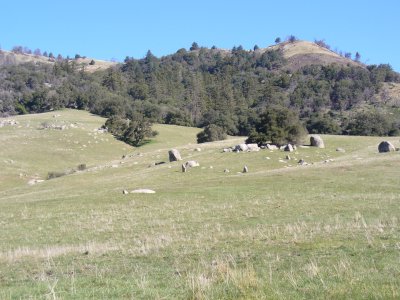Dateline: 3/17/06
By Sheri McGregor
As the weather turns, the soft, warm breezes of spring call for us to revel in the bright green of newly sprouted grass, and the promise of budding blooms that hold sweet scented rainbows inside. With the snow melted and the blue sky brightening their worlds, how do you keep your home schooled children on task? Take the task outdoors, of course. Hiking into nature provides the perfect environment for some whole learning that can cross the subject borders: physical education, science, history, social studies, literature, and art.
Before You Go
Get a local guidebook and research which trails will fit your child’s age and ability, as well as your other needs. Do you want long stretches of easy, flat trail on which to run? Can you bring along the dog? Are you seeking wildflowers for a lesson on native plants, their pollination or cycle of life? Determine your specific needs then find a trail that fits. (See below for hiking preparation and safety tips.)
Decide what you’ll study. Hiking lends itself well to several subject areas. Whether you get cooperative same-grade groups together, or bring your own or others’ homeschooled children of various ages, on-the-trail activities work. Below are a few possibilities.
Ideas
These are just a few of the easy ways you can incorporate hiking into your lesson plans, for fun learning that promotes healthy physical activity. Plan ahead, so that as the weather warms and winter-weary students are anxious for the great outdoors, you can all take a pleasant hike.
1. Have middle grade students research local native plants, then look for and identify them in the field. Have them note what they found and draw pictures in their take-along journals. Back at home or in a cooperative home school group, children can share interesting facts about the plants they researched (verbally or written), or write a poem. You could enrich the study by reading nature essays and literature. Call a local nature photographer or writer to come in and speak to a group of home-schoolers you’ve gathered.
(Subjects: science, art, language arts.)
2.Choose and study a historical journey or event that fits your students’ grade level, then host a re-enactment on the trail. Fifth-graders can learn about Lewis & Clark, for instance then take little red wagons on a wide, flat hike, making notes of what they see just as the historical figures did.
(Subjects: History, Social Studies).
3. Study different types of rocks and how they form, then choose a trail that features some about which the children learned. Have them point out metamorphic or igneous rocks. Small, handheld rock samples are only the beginning. Out on hiking trails, children can get up close to towering boulders, and observe the earth’s work in more magnificent form. Have them use rich language to name the boulders based on shape or surface texture; i.e. “seal,” “hamburger,” “gritty” rock. Have them look at the trail’s soil. Is it made up of smaller, broken pieces of the big rocks they see? Younger children can pour water into the dirt. Is it porous? Dry? Soft? Back at home or in your group, share information about locations around the world where there are interesting, carved or sacred stones such as Easter Island, or islands with volcanic rock. (Subjects: science, physical education, literature, geography).
4. Grab up easels and paints, or drawing pads and pencils, and take children to a hike with a view. Teach them about perspective and let them experiment with it in their own nature art. (Subject: art)
Preparation and Safety Tips
a. Preview the trail, or use a detailed guidebook like one from the 60 Hikes series (right) in order to match the landscape to your lesson plan and children’s abilities.
b. Whether bringing your own children or home-schooled children in a bigger group, outline guidelines and rules such as staying on the trail to avoid snakes or someone getting lost. Have a “trail boss” and someone also bringing up the rear to keep anyone from straggling. Groups may want to invest in two-way radios so everyone can keep in touch.
c. Bring plenty of water. Better to err on the side of too much than too little. Even in mild weather, the body needs hydration. Many public hiking trails do not have drinking water available. Snacks or a picnic lunch are also good ideas.
d. Wear appropriate shoes and clothing. Is poison oak or ivy present? Long sleeves and pants are a plus. Sneakers with good tread are often okay. Actual hiking boots may be a better bet for slippery, rocky, or steep trails.
e. Bring a camera.
f. Most of all – – have fun!
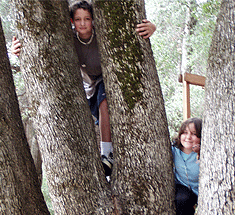 When it comes to physical fitness, San Diego children have a slightly poorer report card than the already dismal national average. The California Department of Education collects statistics from schools’ physical fitness tests, and the compiled data reflects America’s obesity epidemic. Instead of parking in front of the television or computer this weekend, why not enjoy some healthy family time out on the trail? Physical training may also have an interesting side benefit for your kids. The tests also show a correlation between good physical fitness and high academic scores.
When it comes to physical fitness, San Diego children have a slightly poorer report card than the already dismal national average. The California Department of Education collects statistics from schools’ physical fitness tests, and the compiled data reflects America’s obesity epidemic. Instead of parking in front of the television or computer this weekend, why not enjoy some healthy family time out on the trail? Physical training may also have an interesting side benefit for your kids. The tests also show a correlation between good physical fitness and high academic scores. With growing children, time races amid the busy-ness of life. Get out into the wilderness areas of San Diego, hike into a future of good memories and family bonds forged closer through pleasant shared experiences. Besides, hiking builds muscle and stamina –– good for your children.
With growing children, time races amid the busy-ness of life. Get out into the wilderness areas of San Diego, hike into a future of good memories and family bonds forged closer through pleasant shared experiences. Besides, hiking builds muscle and stamina –– good for your children.
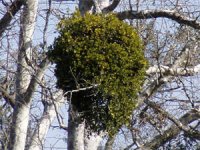 Ancient legends aside, our modern culture recognizes the sprigs of green hanging overhead as an excuse to kiss. This holiday season, what better way to say “I love you” than to stroll hand-in-hand in San Diego’s beautiful wilderness areas? With the songs of birds and the hum of bees all around, pause beneath a patchwork-bark sycamore or other tree, look up into the branches for mistletoe, and lean close for a kiss.
Ancient legends aside, our modern culture recognizes the sprigs of green hanging overhead as an excuse to kiss. This holiday season, what better way to say “I love you” than to stroll hand-in-hand in San Diego’s beautiful wilderness areas? With the songs of birds and the hum of bees all around, pause beneath a patchwork-bark sycamore or other tree, look up into the branches for mistletoe, and lean close for a kiss. Remember that mistletoe can be toxic, so follow the no-collection rule of area open spaces, and leave the plant for others to enjoy.
Remember that mistletoe can be toxic, so follow the no-collection rule of area open spaces, and leave the plant for others to enjoy. Every New Year, scores of San Diegans promise themselves this is their year to get fit. But with the prospect of boring treadmill duty stretched yawningly before them, it’s no wonder so many New Year’s fitness resolutions fail.
Every New Year, scores of San Diegans promise themselves this is their year to get fit. But with the prospect of boring treadmill duty stretched yawningly before them, it’s no wonder so many New Year’s fitness resolutions fail.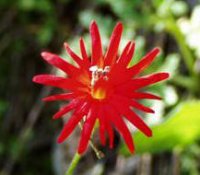 Is your exercise a reward? Try getting out into nature. In San Diego, we’re fortunate to have several hiking areas that don’t require you to “rough it.” Often with learning opportunities and restrooms, San Diego’s natural preserves and open space parks offer a pleasant pastime while getting fit. In our mild climate, just a few steps from city streets, birds sing, flowers bloom, and the Zen-song of trickling
Is your exercise a reward? Try getting out into nature. In San Diego, we’re fortunate to have several hiking areas that don’t require you to “rough it.” Often with learning opportunities and restrooms, San Diego’s natural preserves and open space parks offer a pleasant pastime while getting fit. In our mild climate, just a few steps from city streets, birds sing, flowers bloom, and the Zen-song of trickling To get started, choose short, easy hikes (see the three listed on the left). Then consult the book’s individual trail write ups. These and many others in the book are perfect for beginning hikers starting a New Year’s fitness plan that beats the exercise equipment doldrums. A few steps into nature and you’ll be hooked . . . ready to try more San Diego hikes, which are categorized in the book by length, ease, and criteria including wildlife and water features.
To get started, choose short, easy hikes (see the three listed on the left). Then consult the book’s individual trail write ups. These and many others in the book are perfect for beginning hikers starting a New Year’s fitness plan that beats the exercise equipment doldrums. A few steps into nature and you’ll be hooked . . . ready to try more San Diego hikes, which are categorized in the book by length, ease, and criteria including wildlife and water features. In the fall months, poison Oak, which grows along many local trails in San Diego, can turn vibrant red and yellow. The big bouquets of color lure unsuspecting passersby to touch. Don’t, of course. Remember the three-leaf rule, and be on the watch for colorful foliage that stretches pretty tendrils across trail tracks, and twining up trees. The general rule is “leaves of three, let it be.” More specifically, poison oak’s three-leaf configuration grows with two leaves on either side of the stem, and one extending out like a middle finger (see close up). It’s easy to keep this in mind, and avoid this plant that gestures its irritating nature.
In the fall months, poison Oak, which grows along many local trails in San Diego, can turn vibrant red and yellow. The big bouquets of color lure unsuspecting passersby to touch. Don’t, of course. Remember the three-leaf rule, and be on the watch for colorful foliage that stretches pretty tendrils across trail tracks, and twining up trees. The general rule is “leaves of three, let it be.” More specifically, poison oak’s three-leaf configuration grows with two leaves on either side of the stem, and one extending out like a middle finger (see close up). It’s easy to keep this in mind, and avoid this plant that gestures its irritating nature.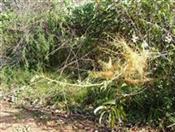 This is the popular nickname for the parasitic plant more officially known as California Dodder. This fleshy gold or orange colored parasite grows in hairy, wig-like clumps over shrubs, brush, and even cactus.A Parasitic Organism Other than its looks, there’s nothing really “witchy” or dangerous about California Dodder to humans. In fact, the Kumeyaay Indians native to our area used to pick and brew California Dodder as a tonic for black widow’s bite. But witch’s hair acts as a vampire to the plants it hosts upon. It latches on and sucks the life right out of them!
This is the popular nickname for the parasitic plant more officially known as California Dodder. This fleshy gold or orange colored parasite grows in hairy, wig-like clumps over shrubs, brush, and even cactus.A Parasitic Organism Other than its looks, there’s nothing really “witchy” or dangerous about California Dodder to humans. In fact, the Kumeyaay Indians native to our area used to pick and brew California Dodder as a tonic for black widow’s bite. But witch’s hair acts as a vampire to the plants it hosts upon. It latches on and sucks the life right out of them! Yuck! Are those wads of spit clumped on plants along the trail? No worries. An uncouth hiker didn’t leave you a disgusting surprise. Those wads of spittle are actually the protective covering of the spittle bug nymph, which surrounds itself with a mass of slimy bubbles formed from plant juices and fluids from its own body.This is just bad manners In time, the harmless spittle bug nymph grows into an adult and leaves the spittle wad to venture out into the world. The tiny adult spittle bug holds the record for the high jump, with an ability to hop to heights over two-feet. The scientific journal Nature reported on an actual spittle bug study. The lead study scientist says the bug’s jumping ability is the equivalent of a human jumping over the Gateway Arch in St. Louis. That’s 630 feet high! Worried about getting hopped on by the adult spittle bug? Don’t be. It’s elusive and harmless, hopping but not . . . mad.
Yuck! Are those wads of spit clumped on plants along the trail? No worries. An uncouth hiker didn’t leave you a disgusting surprise. Those wads of spittle are actually the protective covering of the spittle bug nymph, which surrounds itself with a mass of slimy bubbles formed from plant juices and fluids from its own body.This is just bad manners In time, the harmless spittle bug nymph grows into an adult and leaves the spittle wad to venture out into the world. The tiny adult spittle bug holds the record for the high jump, with an ability to hop to heights over two-feet. The scientific journal Nature reported on an actual spittle bug study. The lead study scientist says the bug’s jumping ability is the equivalent of a human jumping over the Gateway Arch in St. Louis. That’s 630 feet high! Worried about getting hopped on by the adult spittle bug? Don’t be. It’s elusive and harmless, hopping but not . . . mad.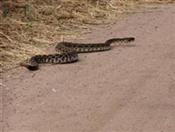 Hibernation is tied to low temperature, not necessarily the turning of a Wild Rattlercalendar page. In San Diego’s sometimes warm fall climate, rattlesnakes can still be out and about.
Hibernation is tied to low temperature, not necessarily the turning of a Wild Rattlercalendar page. In San Diego’s sometimes warm fall climate, rattlesnakes can still be out and about.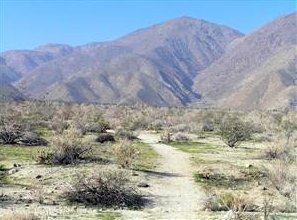 In preparing revisions for the 2nd Edition of 60 Hikes Within 60 Miles: San Diego (due out this coming fall), I’ve been contemplating the word “trail.” In writing up each hike, the word starts to grate: “trail, Trail, TRAIL!” – – ugh! Finding substitute words is a constant.
In preparing revisions for the 2nd Edition of 60 Hikes Within 60 Miles: San Diego (due out this coming fall), I’ve been contemplating the word “trail.” In writing up each hike, the word starts to grate: “trail, Trail, TRAIL!” – – ugh! Finding substitute words is a constant.